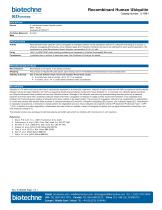 Website:
R&D Systems
Website:
R&D Systems
Catalog excerpts

Recombinant Human UbiquitinCatalog Number: U-100HDESCRIPTION Source E. coli-derived human Ubiquitin protein Met1 - Gly76 Accession # P0CG47.1 Predicted Molecular 8.6 kDa Mass SPECIFICATIONS Activity Recombinant Human Ubiquitin can be conjugated to substrate proteins via the subsequent actions of a Ubiquitin-activating (E1) enzyme, a Ubiquitin-conjugating (E2) enzyme, and a Ubiquitin ligase (E3). Reaction conditions will need to be optimized for each specific application. We recommend an initial Recombinant Human Ubiquitin concentration of 0.01-0.5 mM. Purity >95%, by SDS-PAGE under reducing conditions and visualized by Colloidal Coomassie® Blue stain. Formulation Lyophilized from a solution in deionized water. See Certificate of Analysis for details. PREPARATION AND STORAGE Reconstitution Reconstitute at 10 mg/mL in an aqueous solution. Shipping The product is shipped with polar packs. Upon receipt, store it immediately at the temperature recommended below. Stability & Storage Use a manual defrost freezer and avoid repeated freeze-thaw cycles. • 6 months from date of receipt, -20 to -70 °C as supplied. • 3 months, -20 to -70 °C under sterile conditions after reconstitution. BACKGROUND Ubiquitin is a 76 amino acid (aa) protein that is ubiquitously expressed in all eukaryotic organisms. Ubiquitin is highly conserved with 96% aa sequence identity shared between human and yeast Ubiquitin, and 100% aa sequence identity shared between human and mouse Ubiquitin (1). In mammals, four Ubiquitin genes encode for two Ubiquitin-ribosomal fusion proteins and two poly-Ubiquitin proteins. Cleavage of the Ubiquitin precursors by deubiquitinating enzymes gives rise to identical Ubiquitin monomers each with a predicted molecular weight of 8.6 kDa. Conjugation of Ubiquitin to target proteins involves the formation of an isopeptide bond between the C-terminal glycine residue of Ubiquitin and a lysine residue in the target protein. This process of conjugation, referred to as ubiquitination or ubiquitylation, is a multi-step process that requires three enzymes: a Ubiquitin-activating (E1) enzyme, a Ubiquitin-conjugating (E2) enzyme, and a Ubiquitin ligase (E3). Ubiquitination is classically recognized as a mechanism to target proteins for degradation and as a result, Ubiquitin was originally named ATP-dependent Proteolysis Factor 1 (APF-1) (2,3). In addition to protein degradation, ubiquitination has been shown to mediate a variety of biological processes such as signal transduction, endocytosis, and post-endocytic sorting (4-7). The Ubiquitin product was processed to eliminate glycine and buffer salts which can interfere with chemical and in vitro reactions. References: 1. Sharp, P.M. & W.-H. Li. (1987) Trends Ecol. Evol. 2:328. 2. Ciechanover, A. et al. (1980 ) Proc. Natl. Acad. Sci. USA 77:1365. 3. Hershko, A. et al. (1980) Proc. Natl. Acad. Sci. USA 77:1783. 4. Greene, W. et al. (2012) PLoS Pathog. 8:e1002703. 5. Tong, X. et al. (2012) J. Biol. Chem. 287:25280. Global bio-techne.com info@bio-techne.com techsupport@bio-techne.com TEL +1612 379 2956 USA TEL 800 343 7475 Canada TEL 855 668 8722 China TEL +86 (21) 52380373 Europe | Middle East | Africa TEL +44 (0)1235 529449
Open the catalog to page 1All R&D Systems catalogs and technical brochures
-
DuoSet™ Ancillary Products
3 Pages
-
Recombinant Human IgG1 Fc
1 Pages
-
Recombinant Human Activin A
2 Pages
-
DuoSet™ Ancillary Products
3 Pages
-
Mg-ATP Solution
1 Pages




















